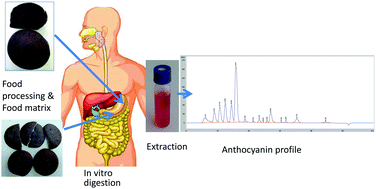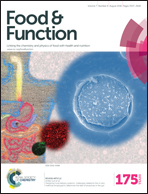Stability and bioaccessibility of anthocyanins in bakery products enriched with anthocyanins†
Abstract
Anthocyanins, water soluble polyphenols, have been associated with several beneficial health effects. The aim of this study was to determine how the baking process and food matrix affect anthocyanin stability and bioaccessibility in bakery products in order to develop functional foods. Three well known regularly consumed bakery products (buns, breadsticks and biscuits) were enriched with anthocyanin (AC) isolated from grape skin alone or in combination with docosahexaenoic acid (AC + DHA) to reveal knowledge on AC as active ingredients in real food systems rather than pure compounds. Anthocyanin amounts added to the formulations of buns, breadsticks and biscuits were 34 mg per 100 g, 40 mg per 100 g and 37 mg per 100 g, respectively. The effect of processing, storage and the food matrix on AC stability and bioaccessibility was investigated. In addition, the sensory properties of bakery products were evaluated. Breadsticks enriched with AC and AC + DHA received the lowest scores in the pre-screening sensory test. Therefore breadsticks were excluded from further analysis. AC retentions, which were monitored by determination of malvidin 3-O-glucoside, in the bun and biscuit after baking were 95.9% (13.6 mg per 100 g) and 98.6% (15.2 mg per 100 g), respectively. Biscuits and buns enriched only with AC showed significantly higher anthocyanin bioaccessibilities (57.26% and 57.30%, respectively) than the same ones enriched with AC + DHA. AC stability in enriched products stored for 21 days was significantly lower than in products stored for 7 days (p < 0.05). However, this loss can be accepted as negligible since more than 70% of AC was retained in all the products.


 Please wait while we load your content...
Please wait while we load your content...